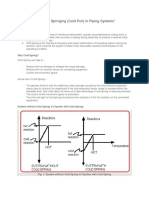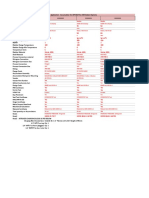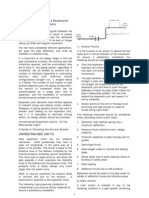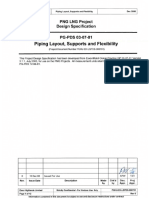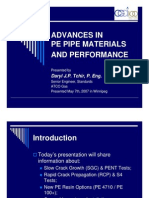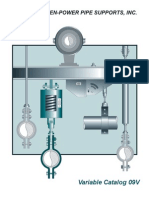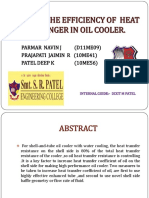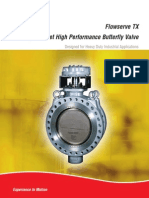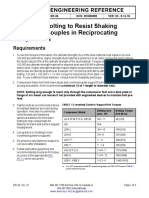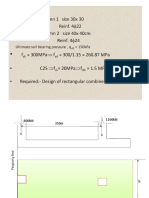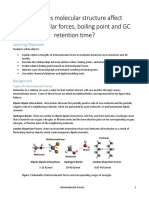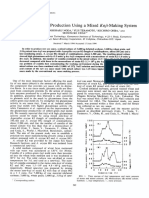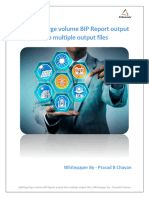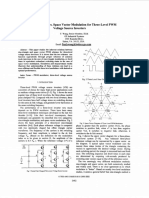Process Piping Systems: Scrubber Design and Installation Requirements
Process Piping Systems: Scrubber Design and Installation Requirements
Uploaded by
Camilo Andres Cardozo FajardoCopyright:
Available Formats
Process Piping Systems: Scrubber Design and Installation Requirements
Process Piping Systems: Scrubber Design and Installation Requirements
Uploaded by
Camilo Andres Cardozo FajardoOriginal Title
Copyright
Available Formats
Share this document
Did you find this document useful?
Is this content inappropriate?
Copyright:
Available Formats
Process Piping Systems: Scrubber Design and Installation Requirements
Process Piping Systems: Scrubber Design and Installation Requirements
Uploaded by
Camilo Andres Cardozo FajardoCopyright:
Available Formats
ER-56.
04 ECN: 201800365 VER: 10 - 07-06-2018
Process Piping Systems
Scrubber Design and Installation Requirements
1. Liquids and solid particulates are incompressible and can negatively impact compressor performance
and reliability. Typically, each stage of compression requires an upstream scrubber to remove free and
entrained liquids from the gas. It is the responsibility of the packager to engineer this system
appropriately for the specific application. The scrubber requires a high liquid level protection system and
an automated drain system. In case of abrasive particle carry-over, contact an experienced filtration
system manufacturer for assistance. A debris sample may be required to determine its properties, origin,
and appropriate filtering techniques.
NOTE: Non-intercooled, dry gas stages of compression may not require liquid separation, but
provisions must be made to remove lubricating oil, if applicable.
2. Design and construct scrubbers in accordance with good engineering practice and industry standards for
two-phase separators and pressure vessels. ISO-13631 provides scrubber specifications. Provide full
diameter skirts with a thickness equal to or greater than the vessel wall thickness (minimum 1/2 inch (13
mm)).
3. Support scrubbers with full-depth structural members.
4. Position all scrubber attachments such as relief valves, sight glasses, instrumentation, drain lines, and
tubing close to the scrubber and support as required. Bullseye style sight glasses are recommended.
5. Ariel requires nozzle reinforcement pads or long weld neck flanges.
Piping Design, Installation, and Package
Construction Requirements
1. During package fabrication, ensure no grinding dust, weld slag, sand, or rain enter the compressor.
When welding on the skid, attach ground connection close to the weld and never to the compressor.
2. Design and install piping without low points that could collect liquids between the scrubber and cylinder;
liquid slugging can result in compressor damage.
3. Design and install piping so it does not distort cylinders and/or crosshead guides. To confirm the piping
imposes no distortion, check crosshead-to-guide clearance after connecting the installed unit to vessels
and piping.
a. No forces or moments should exist on cylinder flanges during assembly. Prying to align flange bolt
holes or “drawing down” to pull piping into position is unacceptable. Before torquing, flange bolts
should thread by hand with no flange contact. Flange gap without torque must not exceed 0.030 inch
(0.76 mm) for one gasket or 0.060 inch (1.52 mm) for two gaskets with an orifice.
b. See TABLE 1 for maximum permissible forces and moments acting on cylinder flanges due to thermal
loads.
ER-56.04, Ver. 10 888-397-7766 (toll free USA & Canada) or Page 1 of 6
740-397-3602 (International)
www.arielcorp.com | arc@arielcorp.com
c. It is impractical to perform thermal analysis on a compressor with the cylinders considered rigid. The
Ariel bore deflection limit is 0.001 inch per inch (0.001 mm per mm) of bore diameter, which may be
used as a cylinder deflection limit.
d. Most unacceptable cylinder deflection comes from severe pipe/bottle misalignment or improper guide
preloading. It is rare for thermal loads alone to cause significant deflection, but they can exacerbate
these problems. Unacceptably high flange forces can cause:
l Low crosshead-to-guide clearance
l Low piston-to-bore clearance
l Low crankshaft thrust clearance
l High rod runout
l Possible cylinder knock
e. Most piping and nozzle failures are due to piping vibration. It is far better to design “on skid” bottles,
pipe, and bracing as stiff as possible to prevent mechanical resonance at low frequencies where
excitation forces are highest, than to design a “soft” piping system to allow thermal growth for “on skid”
piping. Consider thermal forces if using long runs of “off skid” piping. “Off skid” piping better tolerates
thermal stress limiters (thermal loops, flexible bracing, etc.) because pulsation and other shaking
forces are typically attenuated. Design piping with sufficient size to provide equal flow to cylinders in
parallel.
4. Design piping in accordance with good engineering practice and industry standards regarding pressure
and temperature rating, settle out pressures, flow velocity, pressure drop, and material compatibility with
the gas stream.
5. Provide a blow-down vent to safely relieve system pressure for maintenance. Provide a back-flow
prevention check valve for any vent or blowdown line connected to a common vent or flare header.
6. Support and clamp piping in accordance with good engineering practice. Directly attach supports to, or
directly support them by a structural member of the skid or foundation. Support from deck plate or
unistrut clamps is insufficient.
7. Use gusseted band clamps with Fabreeka or an equivalent material between the clamp and pipe to
prevent fretting and corrosion. Some engineering study providers may dictate metal-to-metal contact. Do
not use U-bolt style clamps.
8. Ensure piping rests on the support and is not pulled down by the clamp. Shim if needed.
9. Do not block access to the analyzer drive connection at the crankshaft centerline on the crankcase
auxiliary end. Leave a space 6 inches (152 mm) in diameter and 10 inches (254 mm) long centered at the
crankshaft centerline for analyzer connections.
10. Provide visual access to crankcase oil level sight glass and distribution block cycle indicators.
11. Prior to commissioning, install an inlet gas debris cone strainer with 100 mesh per inch (150 micron)
screen and perforated metallic backing in a pipe spool between the inlet scrubber and first stage cylinder
(s) suction flange. Monitor inlet debris strainer by differential pressure and service it before differential
pressure approaches screen collapse pressure. To protect against screen collapse, use high differential
pressure alarm/shutdown switches. To protect the compressor cylinder(s), mechanically and chemically
clean all piping and vessels thoroughly. Damage results if any construction or manufacturing debris
enters the compressor valves or cylinders.
ER-56.04, Ver. 10 888-397-7766 (toll free USA & Canada) or Page 2 of 6
740-397-3602 (International)
www.arielcorp.com | arc@arielcorp.com
Allowable Forces and Moments at Cylinder Flanges
of Ariel Reciprocating Compressors
FIGURE 1 shows force and moment definitions for
a cylinder flange. These limits apply separately to
suction and discharge flanges. For cylinders with
two suction and discharge flange connections, treat
the two suction connections as one flange and the
two discharge connections as one flange. Follow
the sign notation indicated in FIGURE 1. If the
resultant value of a force or moment is negative,
compare its absolute value against its limit.
Keep compressor flange forces and moments as
low as possible by suitable compensation of piping
forces. Maximum force and moment limits depend
on compressor size.
For compressor flanges pre-loaded cold to
minimize loads after thermal expansion to operating
conditions, both cold and operating conditions must
satisfy the limits.
FIGURE 1 Axis Orientation
TABLE 1 Allowable Forces and Moments at Cylinder Flanges
About the About the About the
Parallel to Parallel to
Vertical Piston Rod Crankshaft Vertical
Frame Piston Rod Crankshaft
(Fy) lb (N) Axis (Mz) Axis (Mx) Axis (My)
(Fz) lb (N) (Fx) lb (N)
lb x ft (N•m) lb x ft (N•m) lb x ft (N•m)
KBB:V:Z:U 3,300 1,600 2,500 3,300 2,500 1,600
(15,000) (7,100) (11,000) (4,500) (3,400) (2,200)
JGC:D:F, KBK:T 1,600 800 1,200 1,600 1,200 800
(7,100) (3,600) (5,300) (2,200) (1,600) (1,100)
JGH:E:K:T 1,300 700 1,000 1,300 1,000 700
(5,800) (3,100) (4,400) (1,800) (1,400) (900)
JG:A:M:P:N:Q:R:J, 900 400 600 900 600 400
KB100 (4,000) (1,800) (2,700) (1,200) (800) (500)
Pulsation Bottles
1. High acoustical pulsation can increase frame, cylinder, gas piping, and equipment vibrations. An
acoustical study will determine if the package requires pulsation bottles when not already required by
customer specifications. An acoustical study will determine if acoustical or mechanical resonances exist
that require correction. When analyzing acoustical pulsation responses, consider single-acting cylinder
and all cylinder load steps. Single-acting cylinders can present the worst case scenario for acoustical
analysis. High acoustically driven vibration can result from single-acting cylinder operation when not
considered. Contact Ariel for information beyond that of the Ariel Performance Program.
ER-56.04, Ver. 10 888-397-7766 (toll free USA & Canada) or Page 3 of 6
740-397-3602 (International)
www.arielcorp.com | arc@arielcorp.com
2. Design and construct pulsation bottles in accordance with good engineering practice and industry
standards for either piping and/or pressure vessels.
3. Design pulsation bottles without traps. Traps allow liquids to accumulate resulting in liquid slugging.
Provide taps for drains and instruments on the bottles. Nozzles protruding into the bottle should be
slotted to prevent liquid accumulation.
4. Install taps for temperature and pressure monitoring as close to the compressor cylinder as possible.
Install the discharge temperature shutdown probe in the 1/2" NPT tap in the cylinder discharge nozzle
provided by Ariel.
5. Position all bottle attachments such as relief valves, sight glasses, instrumentation, drain lines, and tubing
close to the bottle and support as required.
6. Construct pulsation bottles connecting two or more cylinders so as not to strain cylinder flange
connections or distort cylinders.
7. Ariel requires nozzle reinforcement pads.
8. If a mechanical/acoustical analysis predicts high bottle shaking forces, engineered bottle supports and
clamps may be recommended. Bottle supports may not be required on some units if the Packager meets
the following conditions.
a. Piping and bottles assembled to cause no strain on cylinder flanges during compressor operation.
b. Crosshead guide mounting feet firmly supported and properly aligned.
c. Piping properly tied down.
d. Scrubber, piping, or any other skid attachment vibration at a natural frequency prevented during
compressor operation.
9. Avoid suction bottle bracing if possible in the design phase. If bracing is required to comply with
mechanical design requirements or to fix an existing field issue, consider manifold system bracing first
(i.e. bottle to bottle bracing). Knee braces are acceptable as an alternate method with the crosshead
guide lifting eye connection as the preferred compressor attachment point. Consider the following:
a. Brace for resonance tuning. Bracing for forced response motion control may cause excessive stress
on the guide and bottle.
b. Review bottle/cylinder nozzle stresses before bracing. This is common during the mechanical design
process, but it is also important in a retrofit situation.
c. If forces in the support exceed 5% of rated rod load, Ariel Technical Services must review the
application.
d. Brace resonance can be a detrimental side effect. If braces are designed in conjunction with a
mechanical analysis, avoid brace resonance when possible.
e. The attachment point to the guide should utilize a minimum 8:1 bolt stretch by use of a spacer.
f. A brace welded to a re-pad is the preferred attachment to the bottle. Clamp style braces can also be
effective, but they must solidly contact the bottle.
g. Removal of the lifting eye bolt can be difficult due to the use of Loctite 262. Heat helps release the
bond, but take care not to damage lube system components and crosshead babbitt.
h. Some newer large bore cylinders have an extra bolt circle outside the head for head end support
attachments. The upper bolt holes on these cylinders can also be used for suction bottle supports, if
beneficial.
ER-56.04, Ver. 10 888-397-7766 (toll free USA & Canada) or Page 4 of 6
740-397-3602 (International)
www.arielcorp.com | arc@arielcorp.com
Pulsation Bottle Installation
1. Place primary discharge bottle on its adjustable supports in the lowest position. Ensure both cylinder and
bottle flange sealing surfaces are clean and free of damage prior to installation.
2. Adjust primary discharge bottle supports to raise bottle to within 0.125 inch (3 mm) of cylinder flange.
3. Lubricate and insert flange bolts to allow feeler gauge access at 0°, 90°, 180° and 270°. Confirm no bolts
are flange-bound and all bolts can be threaded in completely by hand.
4. Tighten flange bolts to 45–50 ft-lbs (61-68 Nm) to achieve metal-to-metal flange contact without
excessive force applied to the nozzles or cylinders.
5. Record preliminary feeler gauge readings at 0°, 90°, 180° and 270° per flange.
6. Place primary suction bottle on cylinders and install bolts as previously described for the discharge bottle.
7. Verify and record all feeler gauge readings.
8. Minor adjustments to cylinder flange rotation are possible at this time. If this is necessary, crosshead
clearance and piston rod runout must be re-verified.
9. No forces or moments should exist on cylinder flanges during assembly. Prying to align flange bolt holes
or “drawing down” to pull piping into position is unacceptable. Before torquing, flange bolts should thread
by hand with no flange contact. The flange gap without torque must not exceed 0.030 inch (0.76 mm) for
one gasket or 0.060 inch (1.52 mm) for two gaskets with an orifice.
10. Loosen bottle-to-cylinder flange bolts and install gaskets. Confirm no bolts are flange-bound and all bolts
can be threaded in completely by hand.
11. Tighten all bolts in the following sequence:
a. Apply 25% of torque in criss-cross sequence. Tighten repeatedly as required for consistent torque on
all bolts.
b. Apply 50% of torque in criss-cross sequence. Tighten repeatedly as required for consistent torque on
all bolts.
c. Apply 75% of torque in criss-cross sequence. Tighten repeatedly as required for consistent torque on
all bolts.
d. Apply final torque to all flange bolts until consistent torque is achieved on all bolts.
12. Loosen primary discharge bottle adjustable supports in preparation for piping fit and startup.
Discharge Bottle Support Adjustment
Properly adjust bottle supports in accordance with the start up checklist and the maintenance schedule. Ariel
recommends using the following procedure:
1. With the system heat-soaked, shut down the compressor. Loosen the bottle supports and head end
supports (if applicable) so there is no contact between the bottle and support.
2. Place a magnetic base indicator as close as possible to the bottle support with the magnetic base on a
structurally stiff skid member. Place the indicator needle at the bottom center of the bottle. Multiple
supports on a single bottle require an indicator at each support.
3. Tighten the bottle supports only until there is a positive movement on the indicator: 0.003 to 0.005 inch.
ER-56.04, Ver. 10 888-397-7766 (toll free USA & Canada) or Page 5 of 6
740-397-3602 (International)
www.arielcorp.com | arc@arielcorp.com
4. Remove the indicators. Use a locking mechanism to prevent support bolting from loosening or
repositioning if the supports do not contact the bottle when the equipment cools.
5. At this point, adjust head end cylinder supports (if applicable). See ER-56.03.
Relief Valves
1. Provide relief valves on the initial stage suction and the discharge of every stage of compression, set to
operate in compliance with ISO-13631. Install discharge relief valves upstream of each individual gas
cooler section.
NOTE: Consider all possible types of equipment failure or poor operation and protection of
piping systems when selecting relief valve locations and settings.
2. Ensure adequate relief valve settings as well as cylinder and component MAWP's for process settle-out
pressures during shutdown.
3. Pilot operated relief valves must include a back-flow protection feature when connected to a common
vent line.
CAUTION: The compressor cylinder may or may not be the system component with the
lowest pressure rating. Set relief valve based on the lowest rated connected equipment.
Gas Coolers
1. Determine if the package requires gas cooling if not already required by customer specifications.
Consider ambient conditions, anticipated operating conditions, geographical location, and customer
requirements.
2. The discharge gas temperature predicted by the Ariel Performance Program is the expected
temperature at the compressor cylinder discharge flange. Account for any heat loss between the
compressor cylinder and cooler inlet flanges and size the cooler accordingly.
3. Account for cooler fan power consumption when engine driven.
4. Cooler design and construction must comply with good engineering practice and industry standards for
heat exchangers.
5. Consider associated liquid condensates in the cooler design. This includes both heat load and gas flow
from top to bottom through the cooler sections.
6. Some applications require automated temperature control to avoid excessive condensates and dense
phase above critical point. Applications may include heavy gases, CO2, acid gas, etc.
The contents of this document are proprietary and confidential. They are the property of Ariel Corporation and may
not be disclosed, reproduced, or used for manufacture in part or in whole without written permission from Ariel
Corporation.
DATE: VER: ECN: DESCRIPTION:
07-06-2018 10 201800365 Page 2, #9: added "Leave a space 6 inches (152 mm) in diameter and 10 inches (254 mm) long
centered at the crankshaft centerline for analyzer connections."
ER-56.04, Ver. 10 888-397-7766 (toll free USA & Canada) or Page 6 of 6
740-397-3602 (International)
www.arielcorp.com | arc@arielcorp.com
You might also like
- Su27 Eng 1Document103 pagesSu27 Eng 1Alessio ScarabelliNo ratings yet
- Hw4 Mfe Au14 SolutionDocument7 pagesHw4 Mfe Au14 SolutionWenn ZhangNo ratings yet
- Reboiler DiscussionDocument5 pagesReboiler DiscussionlatshareNo ratings yet
- Cold Spring of Restrained Piping SystemDocument5 pagesCold Spring of Restrained Piping Systemsateesh chandNo ratings yet
- Static Method of Wind Analysis of Piping Systems in Caesar II Using Pressure Vs Elevation MethodDocument6 pagesStatic Method of Wind Analysis of Piping Systems in Caesar II Using Pressure Vs Elevation MethodPrakash100% (1)
- Nozzle Loads - Part 1 - Piping-EngineeringDocument5 pagesNozzle Loads - Part 1 - Piping-EngineeringShaikh Aftab100% (1)
- ANZ Technical Guide Heat Exchanger DesigDocument13 pagesANZ Technical Guide Heat Exchanger DesigvikramNo ratings yet
- Pipe Friction Loss of Flowing Pulp SuspensionsDocument1 pagePipe Friction Loss of Flowing Pulp SuspensionsChristian VargasNo ratings yet
- Typical PFD For Centrifugal Compressor SystemsDocument2 pagesTypical PFD For Centrifugal Compressor Systemsandres_old_conde100% (1)
- Theoretical External Collapsing Pressure For Pipelines (Method Is Not Per ASME.)Document1 pageTheoretical External Collapsing Pressure For Pipelines (Method Is Not Per ASME.)NakkolopNo ratings yet
- Cold SpringingDocument5 pagesCold SpringingYakulitoNo ratings yet
- Engineered Spring SupportsDocument43 pagesEngineered Spring SupportsNestor Barranco RadaNo ratings yet
- Valve 1Document22 pagesValve 1Muthukumar ThangaiahNo ratings yet
- Stress and Displacement Analysis of Aerial Oil GasDocument17 pagesStress and Displacement Analysis of Aerial Oil GasDaniel Gómez100% (1)
- Stress Combination Load CasesDocument3 pagesStress Combination Load CasesLcm Tnl100% (1)
- Hydraulic Analysis Versus Piping Stress Analysis ApproachDocument1 pageHydraulic Analysis Versus Piping Stress Analysis Approachalan172081100% (1)
- 347 Stainless Steel Class 2500 Piping SpecificationDocument3 pages347 Stainless Steel Class 2500 Piping SpecificationTrevor Kanode100% (1)
- Pulsating Heat Pipe ReportDocument65 pagesPulsating Heat Pipe ReportIdul Azharul HoqueNo ratings yet
- Acoustic Pipe SupportsDocument6 pagesAcoustic Pipe Supportsnamdq-1No ratings yet
- Nozzle LoadDocument8 pagesNozzle LoadDam VoNo ratings yet
- Sample CalculationDocument35 pagesSample CalculationYoesbar Sofyan100% (1)
- API 682 Accumulator Data SheetDocument1 pageAPI 682 Accumulator Data SheetBhyrappaNo ratings yet
- 4-10 Vacuum Stress in Pipe PDFDocument11 pages4-10 Vacuum Stress in Pipe PDFChristopher BrownNo ratings yet
- The Evolution of ASME Pipe CodesDocument6 pagesThe Evolution of ASME Pipe CodesLuis OrtizNo ratings yet
- Pipeline Stress Analysis With Caesar II PDFDocument16 pagesPipeline Stress Analysis With Caesar II PDFDave M MichaelNo ratings yet
- Pipe Stress Analysis Complete Course From PassDocument2 pagesPipe Stress Analysis Complete Course From Passsleiman shokr100% (1)
- Chapter 1 - Section 3 When To Use NozzleproDocument3 pagesChapter 1 - Section 3 When To Use Nozzleprojohnnyr_5No ratings yet
- Effects of Thermal LoadsDocument12 pagesEffects of Thermal LoadshamadaniNo ratings yet
- PDR 5 Ems 002 R00Document110 pagesPDR 5 Ems 002 R00wan haffizNo ratings yet
- EJMA Example 06Document5 pagesEJMA Example 06Mayank GodhaNo ratings yet
- EGP3-03.20 Technical Requirements For Piping ComponentsDocument31 pagesEGP3-03.20 Technical Requirements For Piping ComponentsMathias OnosemuodeNo ratings yet
- Orifice Plate BrochureDocument39 pagesOrifice Plate Brochureronzies100% (1)
- Analisis of Stress in BellowsDocument101 pagesAnalisis of Stress in BellowsOswaldo Guerra100% (1)
- 10P87-D0003-046-R0-WHRU by TEPLDocument23 pages10P87-D0003-046-R0-WHRU by TEPLjigarNo ratings yet
- Steam Piping in Ammonia Plant at NFCLDocument28 pagesSteam Piping in Ammonia Plant at NFCLVenkatesh VakalapudiNo ratings yet
- PGHU-EH-LSPDS-001209 R1 General Requirement For ValvesDocument13 pagesPGHU-EH-LSPDS-001209 R1 General Requirement For ValvesRiyan EsapermanaNo ratings yet
- Spring - Hanger - Basic PSA Inc PDFDocument26 pagesSpring - Hanger - Basic PSA Inc PDFViji SvrNo ratings yet
- Properties of AirDocument4 pagesProperties of AirRhea FayeNo ratings yet
- Application of Bellows Expansion Joints in Piping SystemDocument5 pagesApplication of Bellows Expansion Joints in Piping Systemjlcheefei9258No ratings yet
- PGHU-EH-LSPDS-000701 R0 Piping Layouts, Supports & FlexibilityDocument12 pagesPGHU-EH-LSPDS-000701 R0 Piping Layouts, Supports & FlexibilityRiyan EsapermanaNo ratings yet
- Behaiviour of PE PipesDocument106 pagesBehaiviour of PE PipeskavoshyarpajouhanNo ratings yet
- BP Variable Catalog 09VDocument52 pagesBP Variable Catalog 09VPetros IosifidisNo ratings yet
- ASME Code Case 2901Document2 pagesASME Code Case 2901sudokuNo ratings yet
- 3D Stress CriteriaDocument5 pages3D Stress CriteriaFernando Diez100% (1)
- Piping Load DataDocument2 pagesPiping Load DatassjunedNo ratings yet
- Drain Philosophy Rev BDocument26 pagesDrain Philosophy Rev BAnonymous nxWj29No ratings yet
- Pump - Suction Side System DesignDocument9 pagesPump - Suction Side System Designashumishra007100% (1)
- Piping DownloadsDocument11 pagesPiping DownloadsAnkit ChughNo ratings yet
- Pipe SleeveDocument2 pagesPipe Sleevepaansaeng_hotmailNo ratings yet
- Buried Pipe - Neven DrobnjakDocument9 pagesBuried Pipe - Neven DrobnjakAnjani PrabhakarNo ratings yet
- Piping PDFDocument29 pagesPiping PDFEzekielNo ratings yet
- Improve The Efficiency of Heat Exchanger in Oil CoolerDocument29 pagesImprove The Efficiency of Heat Exchanger in Oil CoolerMuhammad RustamNo ratings yet
- Trunnion Checking or Dummy Checking During Stress Analysis of A Piping SystemDocument2 pagesTrunnion Checking or Dummy Checking During Stress Analysis of A Piping SystemAmit SharmaNo ratings yet
- Special Requirements For Hydrogen Service ValvesDocument2 pagesSpecial Requirements For Hydrogen Service ValvesTauqueerAhmadNo ratings yet
- Evaluation of Noise Vibration in Boilers at High LoadsDocument76 pagesEvaluation of Noise Vibration in Boilers at High Loadsdelta_scope100% (1)
- Pages From Piping Stress Handbook - by Victor Helguero - Part 2Document1 pagePages From Piping Stress Handbook - by Victor Helguero - Part 2Alborz Mahboobkhah0% (1)
- Web Using FesifDocument3 pagesWeb Using FesifnurilmuNo ratings yet
- Flare Pilot System Safety-TechnicalDocument2 pagesFlare Pilot System Safety-TechnicalParanthaman VikiNo ratings yet
- 1000 SB Fast Clamp Sway Brace AttachmentDocument1 page1000 SB Fast Clamp Sway Brace AttachmentANTONIO GUTIERREZ MIRANDANo ratings yet
- Chapter One: 1.1) Introduction of Pressure VesselDocument55 pagesChapter One: 1.1) Introduction of Pressure VesselAbenezer BirhanuNo ratings yet
- Helical Spring LockwashersDocument4 pagesHelical Spring LockwashersjoseocsilvaNo ratings yet
- TRIPLE OFFSET BUTTERFLY VALVE TX Literature PDFDocument8 pagesTRIPLE OFFSET BUTTERFLY VALVE TX Literature PDFjdietz4No ratings yet
- Er 56 07Document8 pagesEr 56 07Camilo Andres Cardozo Fajardo100% (1)
- Measurement Basics: ANGA Engineering and OperationDocument19 pagesMeasurement Basics: ANGA Engineering and OperationCamilo Andres Cardozo FajardoNo ratings yet
- Er 26 PDFDocument3 pagesEr 26 PDFCamilo Andres Cardozo FajardoNo ratings yet
- ER-10-4-01 EN Installation List Data and Start Up ChecksDocument9 pagesER-10-4-01 EN Installation List Data and Start Up ChecksCamilo Andres Cardozo FajardoNo ratings yet
- CIMAC WG17 2009 Mar Position Performance Gas Engines PDFDocument4 pagesCIMAC WG17 2009 Mar Position Performance Gas Engines PDFCamilo Andres Cardozo FajardoNo ratings yet
- ER-56-03 EN Packager Standards Skid Design and FabricationDocument4 pagesER-56-03 EN Packager Standards Skid Design and FabricationCamilo Andres Cardozo FajardoNo ratings yet
- Training AvrDocument64 pagesTraining AvrCamilo Andres Cardozo FajardoNo ratings yet
- 《Advanced Manufacturing Technology》Experimental ReportDocument11 pages《Advanced Manufacturing Technology》Experimental ReportFarhan mahmud RashikNo ratings yet
- CNG FoundationDocument19 pagesCNG FoundationsamiNo ratings yet
- Intermolecular Forces BackgroundDocument10 pagesIntermolecular Forces BackgroundNicholas DoNo ratings yet
- Time Value 2Document20 pagesTime Value 2Rose BacalsoNo ratings yet
- Sweeper (Brushes With Convoluted Sections) (Two Piece End Caps) (60 - ) - (S - N 434700101 & Above, 714400101 & Above) - SweeperDocument3 pagesSweeper (Brushes With Convoluted Sections) (Two Piece End Caps) (60 - ) - (S - N 434700101 & Above, 714400101 & Above) - SweeperLeidys ORTIZ CONEO100% (1)
- Bca Cbcs Sylllabus Mku 2016 17Document50 pagesBca Cbcs Sylllabus Mku 2016 17SUKUMAR MNo ratings yet
- Circular Measures PDFDocument11 pagesCircular Measures PDFpizamNo ratings yet
- EEE Nodal and Mesh AnalysisDocument26 pagesEEE Nodal and Mesh AnalysisAndrea OnglaoNo ratings yet
- Generating Set Technical Operation and Maintenance ManualDocument25 pagesGenerating Set Technical Operation and Maintenance ManualAlex Treskov100% (3)
- Electronic Pressure Transducers: Upa2 Upa2Document2 pagesElectronic Pressure Transducers: Upa2 Upa2Qatar home RentNo ratings yet
- Examples of Resultant Force and MomentDocument8 pagesExamples of Resultant Force and MomentMustafa JasimNo ratings yet
- Health Sacraments Workbook 2017Document121 pagesHealth Sacraments Workbook 2017André AlexandreNo ratings yet
- Practical Soy Sauce Production Using A Mixed Koji-Making SystemDocument3 pagesPractical Soy Sauce Production Using A Mixed Koji-Making SystemTâm Dương ĐứcNo ratings yet
- X PGNDP0464 03 ECI SPC 020 Control Valve Specification RevADocument7 pagesX PGNDP0464 03 ECI SPC 020 Control Valve Specification RevAgrantNo ratings yet
- AntipodesDocument291 pagesAntipodesAnonymous yAH8LaVDUC100% (1)
- YOLOV10 ExplainedDocument13 pagesYOLOV10 ExplainedSushma MNo ratings yet
- RAINS Radiographic Principles 2019Document32 pagesRAINS Radiographic Principles 2019artspiceNo ratings yet
- VLSI Implementation of Blowfish Algorithm For Secure Image Data TransmissionDocument5 pagesVLSI Implementation of Blowfish Algorithm For Secure Image Data TransmissionnaveenNo ratings yet
- Ambady Rosenthal 92 Thin Slices of Expressive Behavior As Predictors of Interpersonal ConsequencesDocument19 pagesAmbady Rosenthal 92 Thin Slices of Expressive Behavior As Predictors of Interpersonal Consequences22marbieNo ratings yet
- Cat 950 H PDFDocument20 pagesCat 950 H PDFdk_moehammedNo ratings yet
- Unit Outline: MA5.2-1WM MA5.2-3WM MA5.2-15SP MALS-35SP MALS-36SP MALS-37SPDocument37 pagesUnit Outline: MA5.2-1WM MA5.2-3WM MA5.2-15SP MALS-35SP MALS-36SP MALS-37SPapi-408516407100% (1)
- OBIEE Course Contents - v1Document6 pagesOBIEE Course Contents - v1Amit SharmaNo ratings yet
- Splitting Large Volume BIP Report Output Into Multiple Output FilesDocument5 pagesSplitting Large Volume BIP Report Output Into Multiple Output Fileschandan_infotechNo ratings yet
- Sine-Triangle Vs Space Vector Modulation For 3L-VSIDocument7 pagesSine-Triangle Vs Space Vector Modulation For 3L-VSIharkoneneNo ratings yet
- Case StudyDocument7 pagesCase StudyRohaib KhanNo ratings yet
- En 15620Document3 pagesEn 15620Eng AhmedNo ratings yet
- TS 4317 XDocument12 pagesTS 4317 Xwaldo545100% (1)
- Sad Chapter 3 PDFDocument30 pagesSad Chapter 3 PDFAdam TolentinoNo ratings yet










